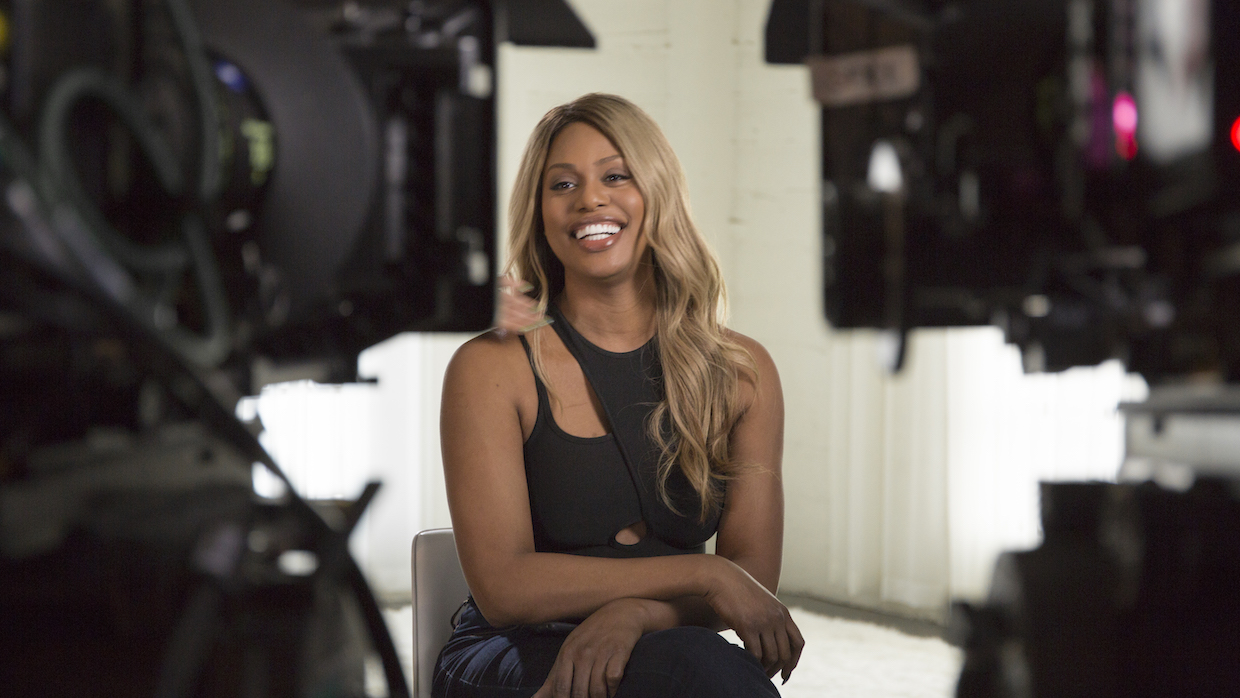 Back to selection
Back to selection
“We Wanted the Stories to Speak for Themselves, Without Distractions”: DP Ava Benjamin Shorr on Disclosure: Trans Lives on Screen
 Laverne Cox in Disclosure: Trans Lives on Screen by Sam Feder (courtesy of Sundance Institute)
Laverne Cox in Disclosure: Trans Lives on Screen by Sam Feder (courtesy of Sundance Institute) The portrayal of trans characters and their experiences comes under much-needed scrutiny in Sam Feders Disclosure: Trans Lives on Screen. Utilizing an archive of trans representation in media throughout the years along with interviews with transgender creatives and thinkers, Feder argues that the exploration of trans stories has often been one-dimensional, disparaging and reflective of our society’s anxieties regarding sex and gender. DP Ava Benjamin Shorr delves into the importance of shooting anamorphic for this film while also navigating the technical difficulties of lighting (and pesky windows).
Filmmaker: How and why did you wind up being the cinematographer of your film? What were the factors and attributes that led to your being hired for this job?
Shorr: Sam Feder, the director of Disclosure, was looking for as many trans crew members as possible to bring onto the project. Since I’m trans and a cinematographer, I believe a few different people in the community recommended me to him. Sam and I got coffee together and instantly hit it off. I’m a film nerd and have a background in documentary so it was a natural fit.
Filmmaker: What were your artistic goals on this film, and how did you realize them? How did you want your cinematography to enhance the film’s storytelling and treatment of its characters?
Shorr: With my cinematography I wanted to create a comfortable, calm space where our subjects could speak at length about not just the history of trans lives on screen, but also how these images have affected them. Since this history is a painful and sometimes violent one, I didn’t want my lighting or camera work to get in the way. Initially, Sam and I floated some ideas of dollies or camera movement, but it wasn’t necessary. We wanted the stories to speak for themselves, without distractions.
Filmmaker: Were there any specific influences on your cinematography, whether they be other films, or visual art, or photography, or something else?
Shorr: Good ol’ portrait style lighting.
Filmmaker: What were the biggest challenges posed by production to those goals?
Shorr: We shot three rounds of interviews. The first were on location and the second two were in a studio. If you’ve seen the interviews, you’ll notice they are staged against two floor-to-ceiling, multi-paned windows which was a visual metaphor Sam wanted to play with. During the first shoot on location, we didn’t have a lot of money or resources and were battling direct sunlight blasting that moved from one window to the other throughout the day. Worse yet, we were on the 10th story of a building, so we couldn’t knock down the sun from the outside and we couldn’t bring generators into the building. What we ending up doing is knocking down both windows with 1.8 ND and a double layer of curtains. Even with a Skypanel full blast on our subject and bringing down the exposure in camera, the windows were still hot. Our saving grace was the Arri log which saved the highlights for us. Fortunately, on the second and third round of interviews we built an identical room in a studio and I had ultimate control over the windows!
Filmmaker: What camera did you shoot on? Why did you choose the camera that you did? What lenses did you use?
Shorr: We shot on two Alexa Minis and Arri/Zeiss Master Anamorphics. I went with the Mini because I knew I wanted to shoot anamorphic and it was the only camera at the time that could shoot true anamorphic without a lot of cropping (i.e. Red). We chose anamorphic because throughout the history of cinema there’s been very little images of trans people shot in the format, the one exception I can think of is Sydney Freeland’s Drunktown’s Finest from 2014. Traditionally, anamorphic has been reserved for Hollywood’s larger than life stories with epic, widescreen vistas—and obviously trans people have never been the heroes in those types of stories. In it’s own way, Disclosure is commenting on and a part of the legacy of trans lives on screen, I thought we should do something cinematographically that elevated us trans folks to a place that’s only been reserved for cis people.
Filmmaker: Describe your approach to lighting.
Shorr: After wrangling the windows, I wanted to make our subjects as beautiful as possible. For each interview, I used a big tungsten beauty dish, diffused it a little bit, and filled in where needed. On darker skin tones I often added more negative fill to eliminate a lot of the white light and reflections bouncing around the room that would show up in little pockets of the face. Occasionally, I’d hit the sides of the face and body with led fresnels that we hung from the grid to give a little definition and separate them from the background.
Filmmaker: Finally, describe the finishing of the film. How much of your look was “baked in” versus realized in the DI?
Shorr: Overall, it was very straightforward. The look we achieved on set was pretty close to where we ended up in the grade. That said, our colorist Luke Cahill ended up elevating my work a lot. All our subjects look stunning. Thanks, Luke!
TECH BOX:
Film Title: Disclosure: Trans Lives on Screen
Camera: Alexa Mini
Lenses: Arri/Zeiss Master Anamorphics
Lighting: Hudson Spider, Lightstar Lightman nine lights, Dedo leds, Litemats, Source 4s
Processing: Digital
Color Grading: Luke Cahill
